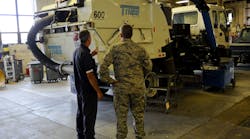Manager: C. J. Slifko
Title: Civilian vehicle mechanic
Company: 22nd Logistics Readiness Squadron (LRS)
Operation: Ensures ground vehicles, supplies, equipment, petroleum, oils, and lubricants are available for the operations of the 22nd Air Refueling Wing
Problem:
Most may think that ground vehicles are an afterthought for the U.S. Air Force. Nothing could be further from the truth, as C. J. Slifko, a retired U.S. Air Force senior master sergeant now serving as a civilian vehicle mechanic with the 22nd Logistics Readiness Squadron (LRS), knows all too well.
The 22nd LRS is a support unit for the 22nd Air Refueling Wing (ARW), which conducts global air refueling and airlift where and when needed out of McConnell Air Force Base in Kansas. The 22nd ARW is one of only three “supertanker” wings in the U.S. Air Force, flying 63 KC-135R Stratotanker aircraft.
Yet those planes need all sorts of ground-based support from a variety of vehicles, even street sweepers, which keep runways and tarmacs free of damaging debris. Thus vehicle uptime—and money spent doing so—plays a critical role in allowing the 22nd ARW to accomplish its mission.
So when personnel noticed a problem on one of the sweeper trucks, they took it to Slifko and his crew—who found a critical safety issue. The unit’s entire roof stood poised to collapse due to rust.
Solution:
Unfortunately, the roof rust posed an expensive problem. The sweeper truck manufacturer’s “hopper assembly” kit cost in the neighborhood of $65,000, not chump change, especially for a military unit ostensibly focused on dedicating most of its resources to aircraft needs.
“Sometimes you can’t help what happens when a truck breaks, so our whole [command] chain very strongly encourages us to come up with new ideas and new ways to save money,” Slifko explains. “I’m all for that.”
That type of can-do attitude ties back into the 22nd ARW’s storied history as well, with the unit’s origins dating to 1940 as the 22nd Bombardment Group. With its Martin B-26 Marauder medium bombers, that unit was one of the first U.S. Army Air Forces units to be deployed in the Pacific Theater after the attack on Pearl Harbor. It later became the 22nd Bombardment Wing, a component wing of Strategic Air Command’s global airborne deterrent force during the Cold War.
And with that heralded lineage in mind, Slifko proposed that his LRS team deploy some elbow grease and take on the task of fabricating the sweeper unit’s hopper assembly in-house. His repair team also fanned out across McConnell Air Force Base to enlist the support of various other shops including the 22nd Civil Engineer Squadron (CES) environmental element and welder teams, which assembled the sweeper body’s metal components.
The 22nd CES, by the way, is the unit responsible for all the real property and equipment installed at McConnell, i.e., supporting base structures, utilities, pavements and grounds, mechanical systems, environmental compliance, fire protection, disaster preparedness, and explosive ordnance disposal.
It had mechanical expertise Slifko knew he could put to work saving money. The end result? Slifko and one co-worker spent a total of 200 worker-hours of labor to build a new sweeper body at a final cost of $3,000, saving his unit more than $60,000.
“We encourage the ability to come up with new ideas and challenge what we typically do,” notes 2nd Lt. Kathryn Gossner, vehicle management flight commander of the 22nd LRS. “We are extremely proud that our airmen [and] our civilians are taking that extra step to think about how we can make this better, how can we do things better. When they are able to make decisions, to take ownership of their job, and come to work inspired, things happen.”



